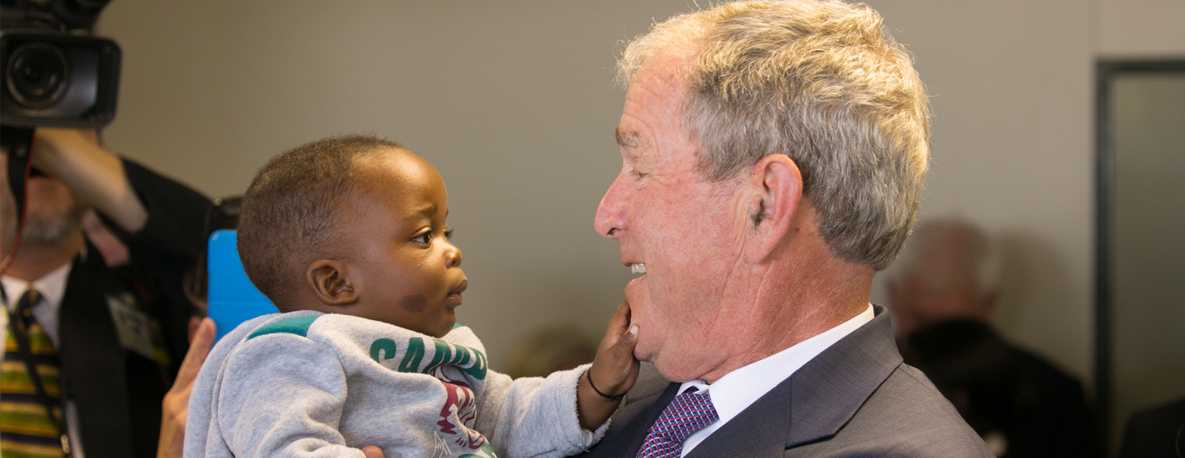Fighting Cancer Among HIV-Positive Women

A classroom of wide-eyed 8 and 9 year-olds listened intently to former US President George W. Bush as he spoke at a primary school classroom in Botswana about efforts to treat and prevent cervical cancer, the most common and deadly cancer among women in the country and a leading cause of death among women living with HIV.
“It broke my heart that even though a woman’s life might be saved from HIV/AIDS, she was needlessly dying of cervical cancer,” he told Diana Pearl of People.com. “I just couldn’t imagine the despondency that would happen in some of these villages where a mom was now living but died of a disease that we could cure and fix with the right kind of policy.”
The former President, along with his wife, former First Lady Laura Bush and the US Global AIDS Coordinator, Ambassador Deborah Birx, were among a group that visited Botswana and Namibia at the beginning of April in support of the global efforts to improve the health of women and girls in the developing world.
Pink Ribbon Red Ribbon (PRRR), Pink Ribbon Red Ribbon video a global health program for women and girls primarily in low- and middle-income African countries, was launched in 2011 by the Bush Institute, the US President’s Emergency Plan for AIDS Relief (PEPFAR), CDC, and other global partners. It works to prevent and treat cervical cancer, and provide services for the early detection and treatment of breast cancer particularly among those already benefiting from HIV antiretroviral treatment. The partnership currently operates in five sub-Saharan African countries –Botswana, Ethiopia, Namibia, Tanzania, and Zambia – as well as Peru.
HIV and cervical cancer are inextricably linked because HPV, the underlying cause of cervical cancer, is more common in women with HIV. In fact, HIV-positive women may be at least five times more likely to develop cervical cancer than those who do not have HIV. PRRR is working to ensure that no woman will survive an HIV diagnosis, only to die of a preventable or treatable cancer. The program is building upon the successes of PEPFAR, launched by the Bush administration in 2003, to reach communities where women are most in need of access to cancer prevention, detection and treatment services, including women currently receiving HIV treatment. PRRR provides women and girls access to receive services toward the prevention and treatment of these cancers.
“We are proud to work with Pink Ribbon Red Ribbon to leverage the existing PEPFAR platform to provide testing and treatment for HIV and cervical cancer—especially for HIV-positive women,” said Ambassador Birx. “We must ensure that women who survive HIV through access to lifesaving antiretroviral treatment do not succumb to cervical cancer.”

CDC’s Division of Global HIV & TB, which plays an essential role in implementing PEPFAR, along with US National Cancer Institute (NCI), supports PRRR efforts through cancer control planning, cancer registries, cancer research, and cancer screening, treatment, and prevention.
In Botswana, where one in five adults has HIV, the former President and First Lady and Ambassador Birx toured the Tlokweng Clinic, which provides screening and treatment for cervical cancer. They also visited the Therisano Primary School to talk with mothers and daughters about the HPV vaccine. CDC currently supports PRRR in sub-Saharan Africa by promoting sustainable solutions for women with HIV and cancer in Zambia, Botswana, and Tanzania.
Ambassador Birx also met with CDC and other PEPFAR staff at CDC-Botswana where she hosted a town hall meeting with Earl R. Miller, US ambassador to Botswana; and Timothy Smith, deputy chief of mission, to discuss PEPFAR’s efforts and impact in support of PRRR and the country’s HIV response more broadly. The PRRR effort in Botswana has reached its fifth year; and since its inception in 2012, more than 22,000 women have been screened for cervical cancer and more than 70,000 girls have been vaccinated against the human papillomavirus (HPV). Also, nearly 120,000 HPV vaccines were administered to girls, more than 25,000 women were treated for cervical cancer, and there have been 400,000 cervical and breast cancer screenings conducted.
“This visit allows us to highlight a powerful five-year partnership that is helping to turn the tide on HIV and cervical cancer for women and girls of all ages,” said Botswana Country Director Michelle Roland of CDC’s Division of Global HIV & TB. “Through our work with PRRR, we are literally saving lives, giving girls a chance at a healthier life, and ultimately, we hope, serving as a model for other countries committed to implementing this important work.”
Following his trip to Botswana, the former President also made his first visit to Namibia to support the launch of the initiative there in partnership with CDC, PEPFAR, UNAIDS, and The Global Fund. The groups have pledged to work together to save the lives of women in Namibia, where cervical cancer is the second most common cancer among women, and more than 120,000 women were living with HIV in 2015.
“While progress has been made, we’ve got to continue to stay in this battle in order to save lives,” said the former President. “Every human life matters.”
Africa Trip Highlights 2017
- Page last reviewed: June 27, 2017, 04:30 PM
- Page last updated: June 27, 2017, 04:30 PM
- Content source:


 ShareCompartir
ShareCompartir